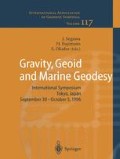Abstract
Sets of planetary spherical harmonic coefficients, because they depict the gravity potential field from the planet surface into the surrounding space, offer two means for estimating the magnitudes of causative mass anomalies. One is from simple ratios, at anomaly centers, of the vertical derivative of the potential (gravity) by its integral (geoid) anomaly value. That ratio gives an estimate of an equivalent point mass depth, and then using that depth with either of the anomaly values used in computing the ratio, a mass estimate is obtained for the equivalent point mass. The ratio of the depths obtained by the gravity over geoid values, divided by the vertical gravity gradient over gravity values, tests the degree to which contributing mass anomalies are co-centric and at a common depth, by deviation from a value of 1.0. The second method analyzes individual harmonic degree contributions, and their consistency for evaluating causative masses. So far this last method has only rigorously been applied to the Earth, revealing that the greatest mass anomalies (about 9×1022 grams) probably result from topography at the core-mantle boundary. [the corresponding simple ratio mass estimates are 1.4 − 1.8×1022 grams] The largest Venus geoid anomaly features have ratio estimated masses of 1.2×1022 and 8.1×1021 grams (with depth ratios of 1.09 and 1.3). Most of Venus’ anomaly features have depth ratio values within 1/10 of 1.0. The three largest Mars geoid anomaly features all correlate with positive topography features and have ratio estimated masses of 5.4, 4.6, and 2.4×1022 grams, but their depth ratio values are 0.71, 0.65, 0.76 (all Mars’ depth ratio values are less than 0.85), indicating more complex structures than on Venus.
Access this chapter
Tax calculation will be finalised at checkout
Purchases are for personal use only
Preview
Unable to display preview. Download preview PDF.
References
Bowin, Carl, 1983, Depth of principal mass anomalies contributing to the Earth’s geoidal undulations and gravity anomalies, Marine Geodesy, V. 7, 61–100.
Bowin, Carl, 1991, Earth’s gravity field and plate tectonics, Texas AM Geodynamics Silver Anniversary of Plate Tectonics Symposium, Tectonophysics, 187, pp. 69–89.
Bowin, Carl, 1994, The geoid and deep Earth mass anomaly structure, in: Geoid and its geophysical Interpretations, Ed. Petr Vanicek, Nikolas T. Christou, CRC Press, Chap. 10, p. 203–219.
Bowin, Carl, Edward Scheer and Woolcott Smith, 1986, Depth estimates from ratios of gravity, geoid, and gravity gradient anomalies, Geophysics, v. 51 (1), p. 123–136.
Marsh, J.G., F.J. Lerch, B.H. Putney, T.L. Felsentreger, B..V. Sanchez, Steve M. Kloskpo, G.B. Patel, John W. Robbins, Ronald G. Williamson, T.L. Engelis, W.F. Eddy, N.L. Chandler, D.S. Chinn, S.Kapoor, K.E. Rachlin, L.E. Braatz, and Erricos S. Pavlis 1990, The GEM-T2 gravitational model, J. Geophys. Res., v. 95, no. 13, p. 22043–22071.
Nakiboglu, S. M. 1982, Hydrostatic theory of the Earth and its mechanical implications, Phys. Earth Planet. Inter., v. 28, p. 302–311.
Nerem, T. S., B.G. Bills and J. B. McNamee, 1993, A high Resolution Gravity Model for Venus: GVM-1, Geophysical Res., v. 20, no. 7, p. 599–602.
O’Keefe, J.A. and W.M. Kaula, 1963, Stress differences and the reference ellipsoid, Science, v. 142, p. 382.
Phillips, R.J. and Kurt, 1980, Gravity fields of the Terrestrial Planets; L on-Wavelength Anomalies and Tectonics, Rev. Geophys. and Space Physics, v. 18, p. 27–76.
Smith, D., F.J. Lerch, R.S. Nerem, 1993, An improved gravity model for Mars: Goddard Mars Model-1, J. Geophys. Res. Planets, v. 98, no. 11, 20871–20889.
Tanaka, S. and H. Hamaguchi, 1993, degree one heterogeneity at the top of the Earth’s core, revealed by SmKS travel times, Dynamics of the Earth’s Deep Interior and Earth Rotation, Geophys. Mon. 72, IUGG, 12, 127–134.
Author information
Authors and Affiliations
Editor information
Editors and Affiliations
Rights and permissions
Copyright information
© 1997 Springer-Verlag Berlin Heidelberg
About this paper
Cite this paper
Bowin, C. (1997). Mass Anomalies of Earth, Venus, and Mars: Initial Estimates. In: Segawa, J., Fujimoto, H., Okubo, S. (eds) Gravity, Geoid and Marine Geodesy. International Association of Geodesy Symposia, vol 117. Springer, Berlin, Heidelberg. https://doi.org/10.1007/978-3-662-03482-8_36
Download citation
DOI: https://doi.org/10.1007/978-3-662-03482-8_36
Publisher Name: Springer, Berlin, Heidelberg
Print ISBN: 978-3-642-08328-0
Online ISBN: 978-3-662-03482-8
eBook Packages: Springer Book Archive

